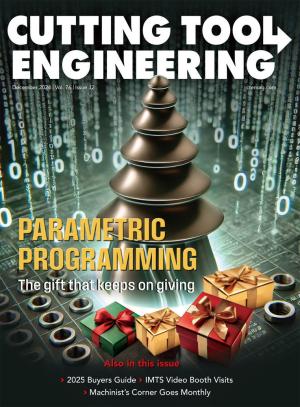The addition of a new chip-breaker option to two insert lineups is billed as a boon to the finish of turning processes.
The move was made by Japan- headquar tered Tungaloy Corp., which recently announced that it has added its JS-style chipbreaker to the company’s AH6225 and AH8015 insert grade product lines. Designed for finishing operations, the JS features large inclination angles on the cutting edge and unique breaker protrusions.
The design aims to ensure effective chip control when cutting to a wide range of depths while also minimizing cutting forces in order to produce high-quality surface finishes.
Key to lowering forces on components is the chipbreaker’s 10° positive top rake angle, according to David Essex, turning product manager at Tungaloy-NTK America Inc. in Arlington Heights, Illinois. “The higher the positive top rake, the more it will shear the material and lighten the tool pressure,” Essex noted.
Combining the JS-style chip-breaker and the AH6225 grade is meant to ensure excellent chip control and extended tool life when finishing workpieces made of stainless steel, steel and high-temperature alloys. To provide longer tool life and high reliability, Tungaloy points out that the AH6225 grade features a hard PVD coating layer with high titanium content, as well as a carbide substrate with high thermal conductivity that dissipates heat generated during machining, which reduces temperatures near the cutting edge.
Added to Tungaloy’s AH8015 grade, the JS-style chipbreaker gives a boost to chip control in finishing operations for heat-resistant alloys and stainless steel. The AH8015 grade features a PVD coating with high-aluminum-content layers that significantly increase its adhesion strength. Benefits include high reliability as well as long and stable tool life, according to the company.
 Tungaloy’s AH6225 and AH8015 insert grades now come with the company’s JS-style chipbreaker. The combination improves chip control while also minimizing heat and cutting forces in order to boost finish quality in turning operations.
Tungaloy’s AH6225 and AH8015 insert grades now come with the company’s JS-style chipbreaker. The combination improves chip control while also minimizing heat and cutting forces in order to boost finish quality in turning operations.
In addition, Essex reported another new development that he believes should be of interest to many machine shops: Tungaloy can now get the nose radii of AH6225 and AH8015 insert grades down to 0.004", as opposed to just 0.008" previously. “Smaller nose radii are important for companies in the medical industry,” he said. While the company has long offered micro grain carbide inserts with nose radii down to 0.001", “with these grades we couldn’t do it because of the (larger) grain size. So we did some work and developed smaller hone radii that enabled us to grind inserts with these larger grain sizes down to 0.004" with good consistency.”
As for limitations, Essex noted that AH6225 and AH8015 grades with the JS-style chipbreaker are not meant for depths of cut under 0.020". But for applications that involve going deeper than that, he noted, the new combination has a lot to offer shops, including the higher productivity that results from longer tool life. When tools last longer, “that means (fewer) times that operators have to stop cutting and open up the machine,” he said. “They can just keep running and making parts.”
Related Glossary Terms
- alloys
alloys
Substances having metallic properties and being composed of two or more chemical elements of which at least one is a metal.
- chipbreaker
chipbreaker
Groove or other tool geometry that breaks chips into small fragments as they come off the workpiece. Designed to prevent chips from becoming so long that they are difficult to control, catch in turning parts and cause safety problems.
- physical vapor deposition ( PVD)
physical vapor deposition ( PVD)
Tool-coating process performed at low temperature (500° C), compared to chemical vapor deposition (1,000° C). Employs electric field to generate necessary heat for depositing coating on a tool’s surface. See CVD, chemical vapor deposition.
- rake
rake
Angle of inclination between the face of the cutting tool and the workpiece. If the face of the tool lies in a plane through the axis of the workpiece, the tool is said to have a neutral, or zero, rake. If the inclination of the tool face makes the cutting edge more acute than when the rake angle is zero, the rake is positive. If the inclination of the tool face makes the cutting edge less acute or more blunt than when the rake angle is zero, the rake is negative.
- turning
turning
Workpiece is held in a chuck, mounted on a face plate or secured between centers and rotated while a cutting tool, normally a single-point tool, is fed into it along its periphery or across its end or face. Takes the form of straight turning (cutting along the periphery of the workpiece); taper turning (creating a taper); step turning (turning different-size diameters on the same work); chamfering (beveling an edge or shoulder); facing (cutting on an end); turning threads (usually external but can be internal); roughing (high-volume metal removal); and finishing (final light cuts). Performed on lathes, turning centers, chucking machines, automatic screw machines and similar machines.








